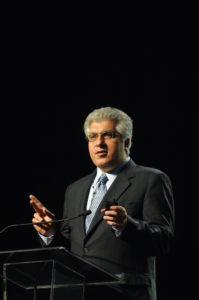
Lackluster Investment Dragging Down GDP Growth
 ATLANTA-A severe lack of investment, especially in technology, explains why gross domestic product (GDP) growth has stalled, according to Rajeev Dhawan of the Economic Forecasting Center at Georgia State University’s J. Mack Robinson College of Business.
ATLANTA-A severe lack of investment, especially in technology, explains why gross domestic product (GDP) growth has stalled, according to Rajeev Dhawan of the Economic Forecasting Center at Georgia State University’s J. Mack Robinson College of Business.
“In the current expansion, investment growth has been a paltry 4.1%, compared to 10.6% in the ’90s,” Dhawan wrote in his quarterly “Forecast of the Nation,” released today (August 24). “No wonder current GDP growth is almost 40% less than the 3.8% seen in the 1990s.”
Real GDP growth over the past three quarters averaged an anemic 1.0%. One year ago, the average for the same three quarters was 2.3%.
“We are in the second pause in growth in the current recovery,” Dhawan said. “The first pause began in mid-2012 after the recovery started in mid-2009. In between these two pauses, GDP growth even touched 5.0% in mid-2014.”
Dhawan points to political uncertainty as the reason this pause will be more prolonged than the last one.
“This pause will be slightly longer because populist rhetoric in this presidential cycle started earlier than usual and has been much, much stronger,” he said. “When we marry this mood with the drop in equipment spending due to collapsing oil prices, clumsy efforts by China to devalue its currency in order to boost growth via exports and frugal consumers worldwide, the result is a growth pause.”
The end of this election cycle should mark the end of this growth pause. “Like after the last presidential election, we have a good chance of bouncing back when this one is over,” Dhawan wrote in his forecast.
The current stock market surge indicates that the exchanges are betting on no change in the political party of the president. However, Dhawan points out that markets reacts poorly when surprised.
“No one knows what the results of the election will be, but we do know how markets react when their herd mentality forecasts the wrong outcome of political events,” Dhawan said. “In June, the Brexit referendum (for the United Kingdom to leave the European Union) didn’t go the way the U.S. stock market anticipated and its reaction was that of a petulant child whose favorite blanket was snatched away.”
“In the short run, the flight to safety (lower interest rates boosting consumption) and the negative wealth impact from the drop in financial markets tend to offset each other.”
The uncertainty of when the U.K. will invoke article 50 to begin its withdrawal from the EU will push most of the economic impact to the medium or long-term. Dhawan predicts that the maximum hit to the U.S. economy will be a negative 0.3% impact on GDP growth.
Highlights from the Economic Forecasting Center’s National Report
- Real GDP will expand 1.5% in 2016, 2.3% in 2017 and 2.1% in 2018.
- Business investment will drop 1.1% in 2016, rebound to 3.3% growth in 2017 and 5.6% in 2018. Jobs will grow by a monthly rate of 183,000 in 2016, 176,000 in 2017 and 151,000 in 2018.
- Housing starts will average 1.152 million units in 2016, rise to 1.242 in 2017 and 1.273 in 2018. Auto sales will drop from 17.1 million units in 2016 to 16.6 in 2017 and 16.0 in 2018.
- The 10-year bond rate will rise to 1.7% in 2016, 2.6% in 2017 and 3.3% by the end of 2018.
